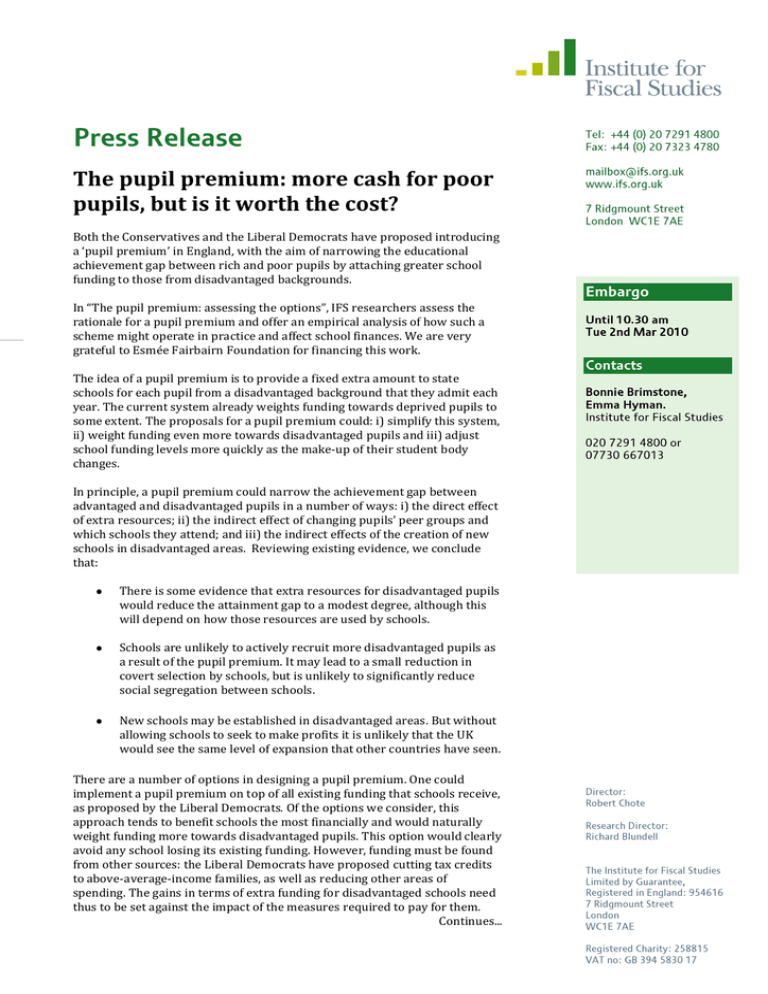The pupil premium: more cash for poor
advertisement

The pupil premium: more cash for poor pupils, but is it worth the cost? Both the Conservatives and the Liberal Democrats have proposed introducing a ‘pupil premium’ in England, with the aim of narrowing the educational achievement gap between rich and poor pupils by attaching greater school funding to those from disadvantaged backgrounds. In “The pupil premium: assessing the options”, IFS researchers assess the rationale for a pupil premium and offer an empirical analysis of how such a scheme might operate in practice and affect school finances. We are very grateful to Esmée Fairbairn Foundation for financing this work. The idea of a pupil premium is to provide a fixed extra amount to state schools for each pupil from a disadvantaged background that they admit each year. The current system already weights funding towards deprived pupils to some extent. The proposals for a pupil premium could: i) simplify this system, ii) weight funding even more towards disadvantaged pupils and iii) adjust school funding levels more quickly as the make-up of their student body changes. In principle, a pupil premium could narrow the achievement gap between advantaged and disadvantaged pupils in a number of ways: i) the direct effect of extra resources; ii) the indirect effect of changing pupils’ peer groups and which schools they attend; and iii) the indirect effects of the creation of new schools in disadvantaged areas. Reviewing existing evidence, we conclude that: There is some evidence that extra resources for disadvantaged pupils would reduce the attainment gap to a modest degree, although this will depend on how those resources are used by schools. Schools are unlikely to actively recruit more disadvantaged pupils as a result of the pupil premium. It may lead to a small reduction in covert selection by schools, but is unlikely to significantly reduce social segregation between schools. New schools may be established in disadvantaged areas. But without allowing schools to seek to make profits it is unlikely that the UK would see the same level of expansion that other countries have seen. There are a number of options in designing a pupil premium. One could implement a pupil premium on top of all existing funding that schools receive, as proposed by the Liberal Democrats. Of the options we consider, this approach tends to benefit schools the most financially and would naturally weight funding more towards disadvantaged pupils. This option would clearly avoid any school losing its existing funding. However, funding must be found from other sources: the Liberal Democrats have proposed cutting tax credits to above-average-income families, as well as reducing other areas of spending. The gains in terms of extra funding for disadvantaged schools need thus to be set against the impact of the measures required to pay for them. Continues... …continued An alternative option would be to finance a pupil premium by abolishing specific grants from central government and streamlining them to form a pupil premium. We show that such a scheme would lead to a very large number of significant losers. Depending on the exact option chosen, around a fifth of schools could experience budget cuts of 10% or more. Such a reform seems unlikely to be politically feasible, even with additional levels of spending. We also consider a more far-reaching option: the creation of a single national funding formula incorporating a pupil premium. Under this policy, local authorities’ role in school funding decisions would be replaced by a single national formula determined by central government. This option has been proposed by the think-tank Policy Exchange and is aspired to by the Conservatives. We show that such an option could be designed to weight funding more towards deprived schools than under the current system. Perhaps surprisingly, the number of significant losers would actually be much lower than through replacing specific grants alone. But depending on the exact option chosen, around one in ten schools could still experience cuts in excess of 10% of their existing funding. More detailed analysis of a national funding formula also illustrates a key problem with such a reform: the concentration of gains and losses in particular local authorities. This pattern does not show up as an urban/rural split; instead, it is likely to reflect local authority choices over services provided centrally, the relative priority given to primary and secondary schools, and historical factors. To ease any transition to a single national funding formula, the size of funding changes from year to year could be capped. The cost of such measures would be small relative to the total schools budget. For example, imposing a floor of 5% on schools’ annual real-terms losses and a ceiling of 15% on increases would enable one of the options to be phased in over five years, at an additional cost of £75 million per year (2010 prices). However, real-terms cuts of 5% are still likely to be painful for any school facing them; schools have become used to real-terms increases. The only way to reduce such losses is through a permanent increase in school funding. Yet committing additional public spending is likely to prove difficult given the level of fiscal restraint required over the course of the next parliament. Luke Sibieta, a co-author of the report and Senior Research Economist at IFS, said: “The key question facing policymakers is: ‘Do the likely gains from implementing a pupil premium – greater levels of funding for deprived schools, a modest reduction in the achievement gap between rich and poor pupils, as well as greater simplicity and transparency – outweigh the potential costs – loss of local discretion and significant levels of cuts to per-pupil funding across some schools?’” Continues... …continued ENDS






